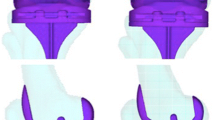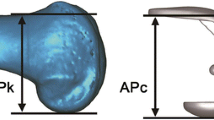Abstract
Purpose
To examine the effect of implantation of the femoral component of a total knee arthroplasty (TKA) system in 0°, 3°, and 6° of flexion on the sagittal plane morphology of the femoral load-bearing surfaces. It was hypothesized that increasing the flexion angle would result in undersizing of the anterior surface without changing the flexion gap.
Methods
Computer simulation of a TKA using three-dimensional models of 10 healthy knees, matched to three different sized femoral components. Size discrepancy in the sagittal plane anterior, distal, and posterior joint surfaces between the native and prosthetic knees was calculated at 0°, 3°, and 6° of flexion.
Results
The required component size varied with the angle of implantation: 0°, size 3/size 4 (N = 7/3), 3°, size 3 (N = 10); and 6°, size 2/size 3 (N = 4/6). Component undersizing ranged between 4.4–6.3 mm at the anterior lateral surface, with a significant difference between 0° and 6° (p < 0.05), and 1.2–3.5 mm at the anterior medial surface. Component oversizing of the distal surface of the lateral condyle (2.9 mm) and undersizing of the medial surface of the posterior condyle (1.6–2.3 mm) were comparable at all three flexion angles of component implantation.
Conclusions
Increasing the flexion angle of implantation increased the incidence of using a smaller size of femoral component without significant interference with the flexion gap. However, the effect of a smaller femoral component on undersizing of the anterior surface of the condyle and the impact on the extensor mechanism need to be considered.




Similar content being viewed by others
References
Abolghasemian M, Samiezadeh S, Sternheim A, Bougherara H, Barnes CL, Backstein DJ (2014) Effect of patellar thickness on knee flexion in total knee arthroplasty: a biomechanical and experimental study. J Arthroplast 29:80–84
Bellemans J, Banks S, Victor J, Vandenneucker H, Moemans A (2002) Fluoroscopic analysis of the kinematics of deep flexion in total knee arthroplasty. Influence of posterior condylar offset. J Bone Joint Surg Br 84:50–53
Bengs BC, Scott RD (2006) The effect of patellar thickness on intraoperative knee flexion and patellar tracking in total knee arthroplasty. J Arthroplast 21:650–655
Bonnin MP, Schmidt A, Basiglini L, Bossard N, Dantony E (2013) Mediolateral oversizing influences pain, function, and flexion after TKA. Knee Surg Sports Traumatol Arthrosc 21:2314–2324
Chang G, Xia D, Sherman O, Strauss E, Jazrawi L, Recht MP, Regatte RR (2013) High resolution morphologic imaging and T2 mapping of cartilage at 7 Tesla: comparison of cartilage repair patients and healthy controls. MAGMA 26:539–548
Chen JY, Yeo SJ, Yew AK, Tay DK, Chia SL, Lo NN, Chin PL (2014) The radiological outcomes of patient-specific instrumentation versus conventional total knee arthroplasty. Knee Surg Sports Traumatol Arthrosc 22:630–635
Ghosh KM, Merican AM, Iranpour F, Deehan DJ, Amis AA (2009) The effect of overstuffing the patellofemoral joint on the extensor retinaculum of the knee. Knee Surg Sports Traumatol Arthrosc 17:1211–1216
Johansson H (1991) Role of knee ligaments in proprioception and regulation of muscle stiffness. J Electromyogr Kinesiol 1:158–179
Johansson H, Sjolander P, Sojka P (1991) Receptors in the knee joint ligaments and their role in the biomechanics of the joint. Crit Rev Biomed Eng 18:341–368
Kawahara S, Matsuda S, Fukagawa S, Mitsuyasu H, Nakahara H, Higaki H, Shimoto T, Iwamoto Y (2012) Upsizing the femoral component increases patellofemoral contact force in total knee replacement. J Bone Joint Surg Br 94:56–61
Kim TK, Kwon SK, Kang YG, Chang CB, Seong SC (2010) Functional disabilities and satisfaction after total knee arthroplasty in female Asian patients. J Arthroplast 25(458–464):e1–e2
Koch PP, Muller D, Pisan M, Fucentese SF (2013) Radiographic accuracy in TKA with a CT-based patient-specific cutting block technique. Knee Surg Sports Traumatol Arthrosc 21:2200–2205
Kuster MS, Bitschnau B, Votruba T (2004) Influence of collateral ligament laxity on patient satisfaction after total knee arthroplasty: a comparative bilateral study. Arch Orthop Trauma Surg 124:415–417
Mahoney OM, Kinsey T (2010) Overhang of the femoral component in total knee arthroplasty: risk factors and clinical consequences. J Bone Joint Surg Am 92:1115–1121
Mihalko W, Fishkin Z, Krackow K (2006) Patellofemoral overstuff and its relationship to flexion after total knee arthroplasty. Clin Orthop Relat Res 449:283–287
Mizner RL, Stevens JE, Snyder-Macker L (2003) Voluntary activation and decreased force production of the quadriceps femoris muscle after total knee arthroplasty. Phys Ther 83:359–365
Mueller JK, Wentorf FA, Moore RE (2014) Femoral and tibial insert downsizing increases the laxity envelope in TKA. Knee Surg Sports Traumatol Arthrosc 22:3003–3011
Murphy M, Journeaux S, Hides J, Russell T (2014) Does flexion of the femoral implant in total knee arthroplasty increase knee flexion: a randomised controlled trial. Knee 21:257–263
Ritter MA, Harty LD, Davis KE, Meding JB, Berend ME (2003) Predicting range of motion after total knee arthroplasty. Clustering, log-linear regression, and regression tree analysis. J Bone Joint Surg Am 85-A:1278–1285
Shakespeare D, Ledger M, Kinzel V (2006) Flexion after total knee replacement. A comparison between the medial pivot knee and a posterior stabilised implant. Knee 13:371–373
Sutter EG, Widmyer MR, Utturkar GM, Spritzer CE, Garrett WE Jr, DeFrate LE (2015) In vivo measurement of localized tibiofemoral cartilage strains in response to dynamic activity. Am J Sports Med 43:370–376
Tarabichi S, Tarabichi Y (2010) Can an anterior quadriceps release improve range of motion in the stiff arthritic knee? J Arthroplast 25:571–575
Tsukeoka T, Lee TH (2012) Sagittal flexion of the femoral component affects flexion gap and sizing in total knee arthroplasty. J Arthroplast 27:1094–1099
Varadarajan KM, Rubash HE, Li G (2011) Are current total knee arthroplasty implants designed to restore normal trochlear groove anatomy? J Arthroplast 26:274–281
Wang Y, Zeng Y, Dai K, Zhu Z, Xie L (2010) Normal lower-extremity alignment parameters in healthy Southern Chinese adults as a guide in total knee arthroplasty. J Arthroplast 25:563–570
Yan M, Wang J, Wang Y, Zhang J, Yue B, Zeng Y (2014) Gender-based differences in the dimensions of the femoral trochlea and condyles in the Chinese population: correlation to the risk of femoral component overhang. Knee 21:252–256
Zeng Y, Wang Y, Zhu Z, Dai K (2012) Effects of sex and lower extremity alignment on orientation of the knee joint line in knee surgery. Chin Med J (Engl) 125:2126–2131
Acknowledgments
This study was supported by the National Natural Science Foundation of China (Grant No. 81272037).
Author information
Authors and Affiliations
Corresponding author
Rights and permissions
About this article
Cite this article
Chen, S., Zeng, Y., Yan, M. et al. Morphological evaluation of the sagittal plane femoral load-bearing surface in computer-simulated virtual total knee arthroplasty implantation at different flexion angles. Knee Surg Sports Traumatol Arthrosc 25, 2880–2886 (2017). https://doi.org/10.1007/s00167-016-3997-1
Received:
Accepted:
Published:
Issue Date:
DOI: https://doi.org/10.1007/s00167-016-3997-1




